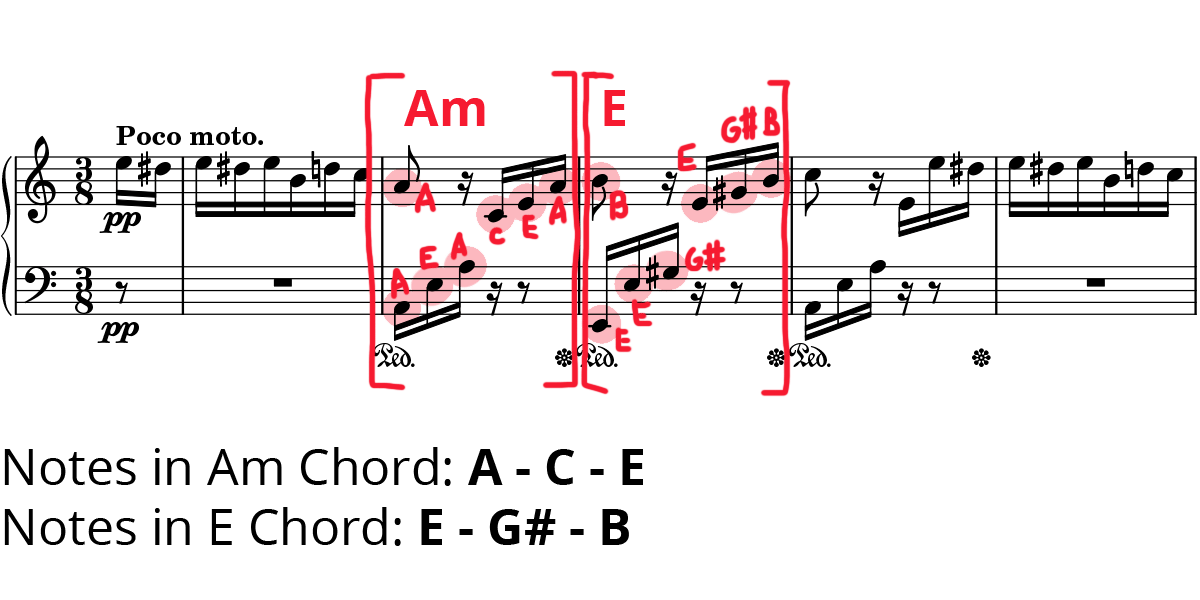If you’ve spent any time with us at Pianote, you know that we LOVE chords!
So, why the hype about chords? After all, most people associate chords with guitar…not piano.
But chords are the foundation to virtually ALL piano music! We’ll show you exactly how in this lesson. And by understanding chords, you’ll be able to play music (classical, jazz, pop, whatever) much, much faster.
Let’s dive in!
Subscribe to The Note for exclusive interviews, fascinating articles, and inspiring lessons delivered straight to your inbox. Unsubscribe at any time.
When you look at sheet music, it may look like there are two lines of music, one on top and one on the bottom. But instead of looking at music horizontally, try looking vertically.
For example, take a look at this piece.

This is “Für Elise” by Beethoven, one of THE most popular classical pieces of all time, and a piano favorite.
It may look like two lines of music, but it’s actually entirely built up of chords, mainly the Am and E chords. The Am chord contains the notes A-C-E and the E chord contains the notes E-G#-B.
You’ll find that parts of the melody and harmony have notes straight from these chords!

Pretty neat, huh?
So how does this knowledge help us learn and play songs? Let’s look at another Beethoven classic: the legendary “Moonlight” Sonata.
“Moonlight” Sonata is a favorite among pianists. It sounds so moody and beautiful, but it’s not an easy song.
But here’s a shortcut: chords!

Instead of reading each and every single note in this intro (which makes me anxious!), I see the music in chords. I see that in the first measure, my right hand is playing C#m chord in 2nd inversion (G#-C#-E) and I’m playing the root note (C#) with my left hand.
In the second measure, I’m playing the same C#m chord in 2nd inversion with my right hand and B in my left. This is a C#m/B slash chord.
Finally, in the third measure, I play a root position A chord and then a D/F# chord where I play 2nd inversion on my right hand, and I play F# as my bass.
When you know chord shapes very, very well, you can identify the inversion shape of a chord quickly.
A fine way to start songwriting is by improvising on a song you already know and love.
In my video example with “Moonlight” Sonata, I riff on the opening passage by playing it like this:

In this example, I:
…yet I’m using the same chords!
The intro is shrunk to two measures as a result. And already, I feel like writing a pop song over Beethoven’s progression!
Finally, a solid understanding of chords will help you learn to play virtually any song you hear on the radio.
Once you know how to read chord symbols, you can visit Ultimate-Guitar.com and download a chord chart (the website has free chord charts available for most pop songs). Then, play the chords over the song and you’re all set!
If you’re a little more advanced, you can build out those chords into arpeggios. Then, add riffs, fills, and twinkles to personalize your performance.
As you can see, knowing your chords gives you BIG advantages. Chording will help you play classical music, jazz, pop, and more.
If you want to brush up on your chords, check out the Chording section of our blog or take a deep dive through this guide. If you want a more hands-on intro, check out our FREE Chord Hacks course!
And as always…happy practicing!
Lisa Witt has been teaching piano for more than 20 years and in that time has helped hundreds of students learn to play the songs they love. Lisa received classical piano training through the Royal Conservatory of Music, but she has since embraced popular music and playing by ear in order to accompany herself and others. Learn more about Lisa.
/marketing/pianote/promos/april/banner-bg-m.webp)
We use cookies for traffic data and advertising. Cookie Policy »
/marketing/pianote/promos/april/banner-title.webp)